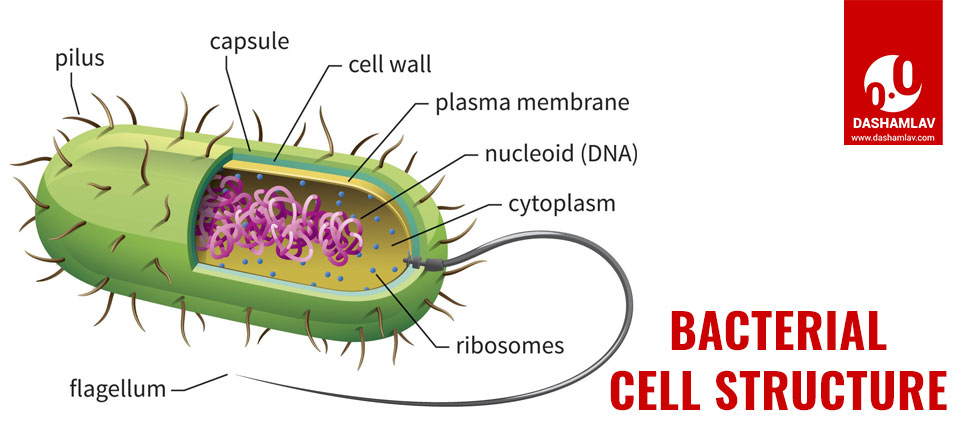What is Bacteria?
Definition: Bacteria are single-cell, prokaryotic microorganisms.
Bacteria are present everywhere on the planet Earth, including on the bodies of other organisms and inside them too. These microorganisms are found in soil, water, deep in the oceans, hot springs, radioactive waste — practically everywhere including the most extreme conditions! Bacteria also live in symbiotic and parasitic relationship with other organisms.
There are evidences suggesting that bacteria were in existence even 3.5 billion years ago. Therefore, they are one of the oldest living organisms on the Earth.
They are found in large number of shapes but typically they are circle or spherical (coccus), rod-like (bacillus), spiral or filamentous.
For most people the word bacteria refers to something horrible. But truth is that only some bacteria are harmful for us. In contrast most of the bacteria are actually useful for us in one way or the other. For example, the curd you eat is made by and contains a wide variety of bacteria like Lactobacillus acidophilus, Lactococcus lactis, Lactococcus lactis cremoris etc.
Structure of Bacteria
Although bacteria are found in many shapes, the typical bacterial cell structure remains same. Following illustration shows the structure of a typical bacterial cell:

Capsule
Some bacteria have an outermost layer made of polysaccharides, called capsule. This layer protects bacteria from drying and also from getting engulfed by bigger organisms. More importantly for us, this capsule is a major virulence factor in the major disease-causing bacteria, such as Escherichia coli and Streptococcus pneumoniae. The mutant forms of these bacteria that do not have capsule, do not cause disease as well.
Cell Wall
All bacteria have a cell wall made of peptidoglycan. Due to its rigid nature, the cell wall provides shape and protection to the bacterial cell. Composition of cell wall plays a very important role in classification of bacteria. Gram staining is a bacterial cell staining technique developed by Hans Christian Gram in 1884. Bacteria with thicker cell wall, retain the violate stain and are called Gram-positive bacteria. Bacteria with thin cell wall release the dye, when washed with alcohol, and are called Gram-negative bacteria.
Plasma / Cytoplasmic Membrane
Also known as Cell membrane, this thin layer made of phospholipids and proteins envelops the cytoplasm and cell organelles. One of the most important role of plasma membrane is to regulate the flow of material in and out of the bacterial cell.
Flagella
Flagella are a tail like formation attached to the bacterial cell. Not all bacteria have flagella but where flagellum is present, it helps the bacteria in locomotion. This movement from one point to another is important for certain bacteria as they can’t be stationary and need to move away from harmful conditions and towards the nutrients.
Nucleoid
The genetic material (DNA) in bacteria is not bound by a nucleus membrane. Therefore, the region in cytoplasm where DNA is located is called nucleoid (meaning like a nucleus). Most of the bacterial genome consists only of just one circular chromosome. This chromosome is responsible for replication of bacteria.
In addition to the chromosomal DNA, most bacteria also contain small independent pieces of DNA called plasmids.
Pili
Multiple hair-like attachments to the bacterial cell are called pili (singular pilus). Only some bacteria species have pili. These projections help bacteria to attach to a surface (e.g. intestine of an animal or a even rock). It has been seen that many disease-causing bacteria lose their virulence if they lose pili. Without pili, they have no means to attach to the host.
Ribosomes
Ribosomes are responsible of translating the genetic code from nucleic acids into the amino acids. Bacterial ribosomes are present throughout the cytoplasm.
Types of Bacteria
Bacteria Types Based on Shape
On the basis of shape, bacteria are often divided into the followings types:
- Rod-shaped (bacilli) — for example Actinomyces, Clostridium, Corynebacterium, Listeria, Propionibacterium, Bacteroides, Citrobacter, Enterobacter, Escherichia, Klebsiella, Pseudomonas, Proteus, Salmonella, Serratia, Shigella, Vibrio and Yersinia etc.
- Circular or spherical (coccus) — for example Streptococcus pneumoniae, Neisseria gonorrhoeae, Streptococcus pyogenes, Staphylococcus aureus and Sarcina ventriculi etc.
- Spiral-shaped — for example Campylobacter jejuni, Helicobacter pylori, Borrelia burgdorferi and Treponema pallidum etc.
- Filamentous — for example Actinomycetes and Nocardia
- Between rod and sphere (Coccobacillus) — for example Haemophilus influenzae, Gardnerella vaginalis and Chlamydia trachomatis etc.
Bacteria Types Based on Gram Staining
Based on their ability to retain Gram stain, the bacteria can be of two types:
- Gram-positive bacteria: These are the bacteria with thick cell wall and they retain violet Gram stain.
- Gram-negative bacteria: Do not retain Gram stain and appear red/pink under microscope when stained with safranin. Most of the pathogenic bacteria are Gram-negative.
Bacteria Types Based on Ability to Make Food
- Autotrophic bacteria: Some bacteria, for example Cyanobacteria, can make their own food through the process of photosynthesis. They do not depend on other organisms for their food.
- Heteroptrophic bacteria: These are the bacteria which can not carry out photosynthesis and have to get their food from outside.
Use the citation below to add this article to your bibliography
"What is Bacteria? Learn Definition, Types and Structure with Diagram." Dashamlav.com. Web. 27 July 2024. <https://dashamlav.com/bacteria-types-definition-structure-diagram/>
Dashamlav.com, "What is Bacteria? Learn Definition, Types and Structure with Diagram." Accessed 27 July 2024. https://dashamlav.com/bacteria-types-definition-structure-diagram/
"What is Bacteria? Learn Definition, Types and Structure with Diagram." (n.d.). Dashamlav.com. Retrieved 27 July 2024 from https://dashamlav.com/bacteria-types-definition-structure-diagram/
